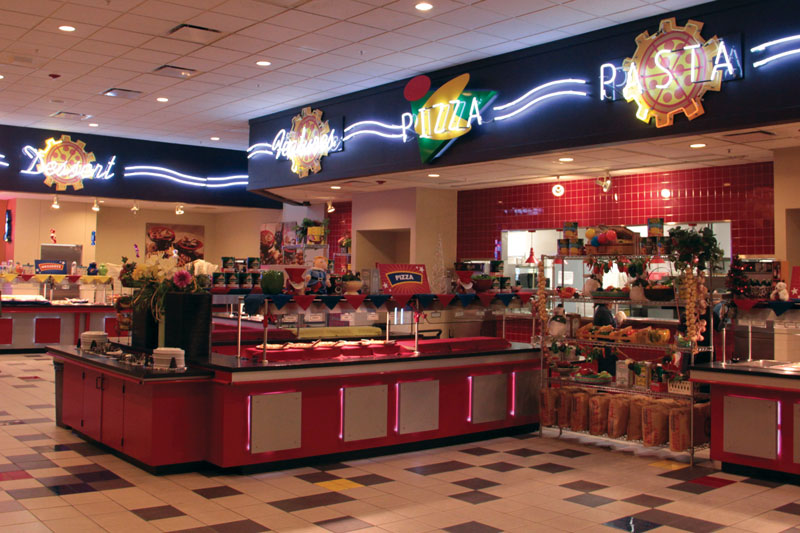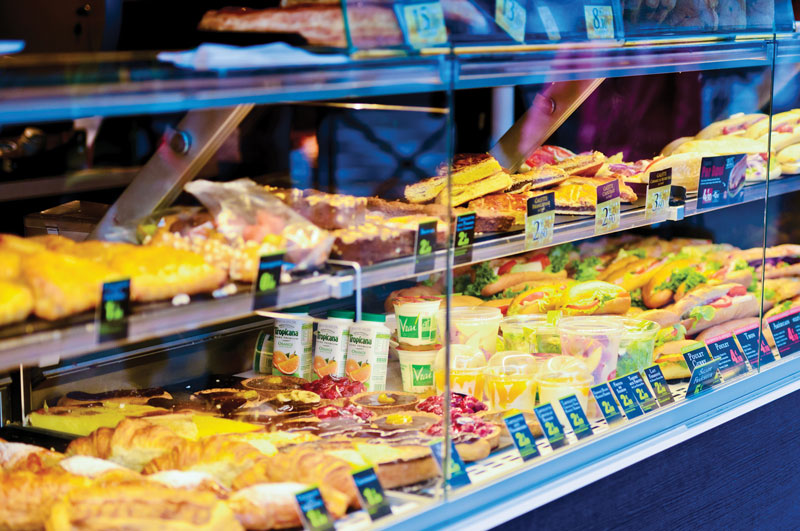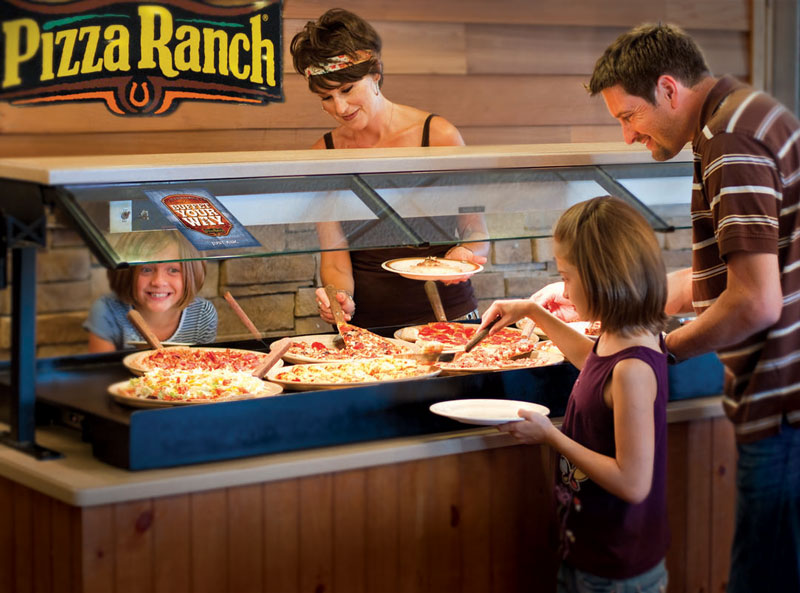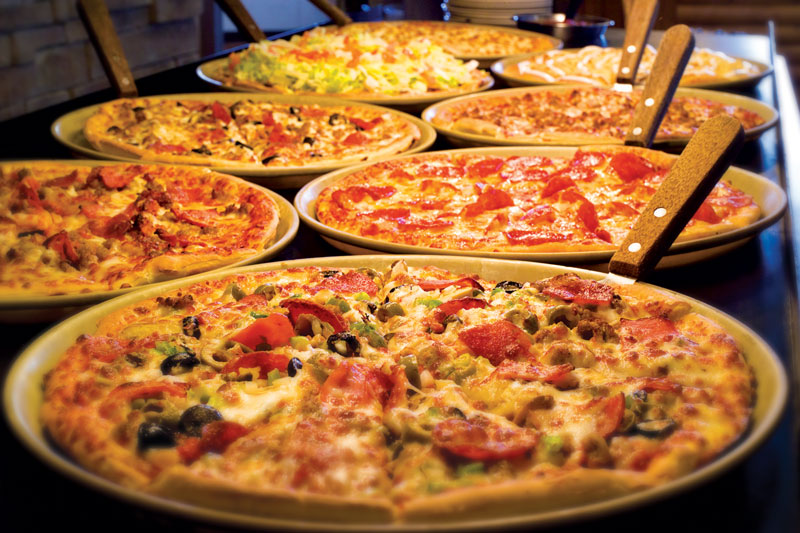Pizzerias have been struggling to grab a slice of the lunchtime crowd for years. Adding sandwiches and salads has helped, but many consumers still consider a visit to the pizzeria too time- consuming—and expensive—for a quick lunch. Enter the pizza buffet. Budget-friendly and convenient for customers, buffets and pizza tend to go hand in hand.
But buffets aren’t for everyone. If you don’t want to be open for lunch, invest in buffet equipment or coordinate your staff to monitor stations, you may want to stop right here. “It’s important to enter into something like buffet service with your eyes wide open,” advises Allen Wachter, vice president of marketing for Omaha, Nebraska-based The Amazing Pizza Machine, which offers more than 100 items on its buffet. “There will be busy and slow times of the day. We may see 100 people during a slow time and 1,000 during a busy Saturday. Ask yourself whether you can afford the waste if no one walks in for the buffet one day.”
If you don’t mind taking that risk, a buffet could jump-start your lunch business. David Goldy, owner of Wild West Pizza in Lompoc, California, has been offering a $6.99 lunch buffet since he opened two years ago. “Lunch is often a difficult segment for the pizza industry if you don’t have a ready-now option,” Goldy notes. “We offer the buffet from 11:30 a.m. to 2:30 p.m., seven days per week. It includes all-you-can-eat pizza, salad, soup and soda, and we sell about 50 buffets per day.”
 |
|
The Amazing Pizza Machine offers more than 100 options on its buffet, which is priced at only $8.99 for adults and $5.99 for kids. |
People like the idea of instant dining, Wachter adds. “Our customers enjoy variety and versatility, especially within families,” he says. We’re open all day, but our busiest times are evenings, weekends and when the kids are out of school.”
Ready to go all the way with buffet? PMQ inquired at buffet establishments of various sizes—small, medium and large—to find out what it takes to set one up.
Bare Necessities
First and foremost, you’ll need space in your building for a buffet. Depending on your pizzeria and your customer base, this could mean a 5’-by-5’ space or one-quarter of your dining room. “Our restaurant seats over 700,” Wachter says. “If you offer a buffet, you’ll need to have enough seats to accommodate the crowd.” Ideally, Wachter says, your buffet service should offer items that appeal to a wide range of ages, including cheese pizza, a salad bar and changing protein options.
“A lot depends on the size of your building, the number of seats you’re going to have, and how much kitchen space you need,” says Cody Pierce, vice president of marketing for Orange City, Iowa-based Pizza Ranch, with 194 locations in 13 states. “We have two or three different sizes of buffets that hold eight to 10 pizzas and what we call a two-well, three-well, four-well chicken system. So it depends on the projected volume of the restaurant and several other factors.”
Menu Options

Grab-and-Go Displays |
| Not ready to offer a buffet? Start with a grab-and-go display. Everyone is in a hurry nowadays, and many appreciate the convenience of grab-and-go items in a refrigerated case. You can even repurpose one of your existing glass-front fridges to save on cost while testing the concept. Package a variety of salads, sandwiches, soups and desserts that are ready to go and promote the new offering on your website and social media. You may be surprised to see how many guests stop by before lunch or add items to their carryout orders. |
Choosing a menu mix for your buffet will depend on its size, customer demand and demographics. “We have a lot more than pizza,” Wachter says. “Along with 14 different pizzas, we have pasta, salad, soup, nightly specials and more.”
“We always feature four pizzas at once—usually pepperoni, Hawaiian, veggie, and a chicken selection,” Goldy adds. “We also have a small but plentiful salad bar and three soups daily.”
Pizza Ranch, meanwhile, offers a “limited buffet,” according to Pierce. “We have a pizza buffet, a hot buffet with chicken and sides, and a salad bar. We offer everything for carryout and delivery, but 80% of our business is buffet.”
Pierce adds that Pizza Ranch always has a limited- time-only offering that’s featured for about four months alongside staples such as Cheesy Ranch Stix with cheese and pepperoni. They also rotate one- or two-topping pizzas and a selection of 14 specialty pizzas. “On the hot bar, we always have fried chicken, mashed potatoes and gravy, and then usually vegetables and potato wedges,” says Pierce. “On the salad bar, we always have a fresh green salad and a limited-time-only salad, along with 30 various salad bar options.”
Special Requests
While buffets typically offer a little something for everyone, some customers will undoubtedly put in special requests. With this in mind, Pizza Ranch offers the Buffet Your Way program. “If a guest doesn’t see what he wants [in the pizza bar], he just lets us know what it is, and we bring out as many slices as he’d like and put the rest on the buffet,” Pierce says.
Not all pizzerias can accommodate special requests all of the time, though, especially when they have a small buffet or a very large buffet with many choices. “We will take some requests, space permitting,” Goldy notes. “However, if there are four full choices already available, we do not take special requests.”
Wachter agrees, adding, “We have 14 different types of pizza on the buffet. The only special request we usually take is for gluten-free crust.”
Price Pointers
Consumers expect good value from buffet service, so while you need to cover your food costs, try not to price yourself out of the market. Depending on your offerings and your labor costs, you may consider a lower cost for lunch and a higher price for a dinner buffet, if you decide to offer the latter.
The lunch buffet at Pizza Ranch is typically $1.50 less than the evening/weekend buffet price. “Setting a price starts with understanding your labor rates and how much labor you’re going to use at the buffet,” Pierce says. “Check out local competition; that will help guide your price. You already know your food cost. So taking those three things into consideration, that’s where you’ll be able to price your buffet for lunch and dinner.”
“Our buffet is value-priced at $6.99, and thus we try to limit it to more basic pizzas, but we also use it as a vehicle to sample new offerings,” Goldy says. “Our price was really based on our competitive environment. As the new guys on the block in our town, we have it priced a bit lower than our competitors.”
With more than 100 options on the buffet at The Amazing Pizza Machine, you might expect a higher price point. But the pizzeria also uses games, rides and attractions—purchased in packages or a la carte—to bring in customers and drive revenue, allowing them to keep the buffet price down. Adults pay just $8.99, while kids ages three to 12 eat for $5.99.
 |
|
The most successful buffets, like the one at Pizza Ranch, have something for moms, dads and the kids. Photo provided by Pizza Ranch. |
Stocking and Management
| Myth Buster |
| Will customers eat you out of your profits if you offer a buffet? Cody Pierce, vice president of marketing for Orange City, Iowa-based Pizza Ranch, says no. Pizza Ranch doesn’t go through any more food than a regular pizzeria, he says. “We don’t have higher food costs because people are eating more,” he says. “We know how much food we’re going to go through, and that doesn’t change much.” |
One thing your buffet-loving guests cannot abide is a depleted tray or empty well. “There’s nothing worse than running out of pizza on the buffet,” Goldy says, but a little smart planning and structure can help avoid that problem. “Pretop pizzas so you can drop them right into the oven,” he recommends. “You should also create a rule, such as ‘one new pizza dropped for every two buffets sold.’ And you should have a system to time individual pizzas so you can replace them on the buffet after a specific time period.”
Wachter says it’s often easier to run a buffet when it’s busy than when it’s slow. “You have to be very conscious about the portions you’re putting out,” he advises. “When you have more customers, you need more staff in order to divide up the responsibilities. Watch the portions and constantly communicate with the kitchen staff.”
“We have our kitchen set up so we have pizza on one side and chicken on the other,” Pierce says. “One side has the pizza ovens and make tables, and the other side has the chicken fryers—they meet in the middle. Then we have staff stationed at the pizza, chicken or salad bar; their sole job is to maintain those buffets and report back to the kitchen regarding what’s needed. It’s our job to time everything so we’re never out of anything. Keeping a full, hot, fresh buffet all of the time is very important for guest satisfaction.”
In the end, buffets aren’t a get-rich scheme or a way to cut down on food or labor costs. In fact, as consumers worry more about their health and weight, buffet sales have declined slightly in the United States. According to the online statistics portal Statista.com, food and drink sales of buffets and cafeterias were expected to reach $8.34 billion in 2015, a small drop from 2014’s figure of $8.43 billion. You should do your research and offer buffet service only if you’re sure it’s the right solution for your specific demographic.
“Buffets aren’t easy, or everyone would be doing them,” Pierce concludes. “You have to make sure you’re monitoring your product and delivering hot, fresh and full buffets all the time, or you run the risk of people being upset. People are coming to a buffet because they want choice, so making sure you have that is really important.”















